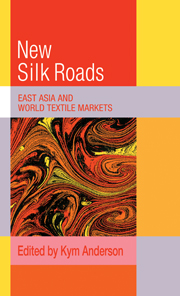Book contents
- Frontmatter
- Contents
- List of figures
- List of tables
- Contributors to this volume
- Preface
- Abbreviations and acronyms
- Symbols
- Introduction and summary
- I FIBRES, TEXTILES AND ECONOMIC DEVELOPMENT
- 1 The changing role of fibres, textiles and clothing as economies grow
- 2 The experience of Japan in historical and international perspective
- 3 Effects of China's dramatic reforms on its neighbours and on world markets
- 4 Thailand's growth in textile and clothing exports
- II DEMAND FOR TEXTILE EXPORTS FROM NEWLY INDUSTRIALIZING ASIA
- III CONCLUSIONS
- Appendix: Data on world production, consumption and trade in textiles, clothing and fibres
- Bibliography
- Index
1 - The changing role of fibres, textiles and clothing as economies grow
Published online by Cambridge University Press: 19 January 2010
- Frontmatter
- Contents
- List of figures
- List of tables
- Contributors to this volume
- Preface
- Abbreviations and acronyms
- Symbols
- Introduction and summary
- I FIBRES, TEXTILES AND ECONOMIC DEVELOPMENT
- 1 The changing role of fibres, textiles and clothing as economies grow
- 2 The experience of Japan in historical and international perspective
- 3 Effects of China's dramatic reforms on its neighbours and on world markets
- 4 Thailand's growth in textile and clothing exports
- II DEMAND FOR TEXTILE EXPORTS FROM NEWLY INDUSTRIALIZING ASIA
- III CONCLUSIONS
- Appendix: Data on world production, consumption and trade in textiles, clothing and fibres
- Bibliography
- Index
Summary
This chapter addresses the first of the questions posed above in the introduction, namely: how is the relative importance of fibre, textile and clothing production and trade in an economy likely to change as that economy and the rest of the world grow? It begins by drawing on trade and development theory to develop hypotheses about the changing patterns of trade specialization, and then examines global evidence to show the extent to which those hypotheses are supported. In fact the available evidence provides very strong support for the theory. This allows that theory to be drawn on with confidence in subsequent chapters which explore in more depth the recent and prospective experiences of the rapidly industrializing economies of East Asia.
Standard trade and development theory
Much of the production and employment of a low-income economy involves the provision of essentials, namely food and fibre. Agriculture's shares of GDP and employment thus start at high levels. However, as economic development and commercialization proceed, agriculture's relative importance typically falls. This phenomenon is commonly attributed to two facts: the slow rise in the direct demand for food and to a lesser extent fibre as compared with other goods and services as incomes rise, and the rapid development of new technologies for agriculture relative to other sectors which leads to expanding farm output per hectare and per worker (Schultz 1945: chs 3–5; Kuznets 1966: ch. 3; Johnson 1973: ch. 5). Together these two facts ensure that in a closed economy (including the world as a whole) both the quantity and the price of agricultural relative to other products will decline, as will the share of employment in agriculture.
- Type
- Chapter
- Information
- The New Silk RoadsEast Asia and World Textile Markets, pp. 2 - 14Publisher: Cambridge University PressPrint publication year: 1992
- 1
- Cited by



